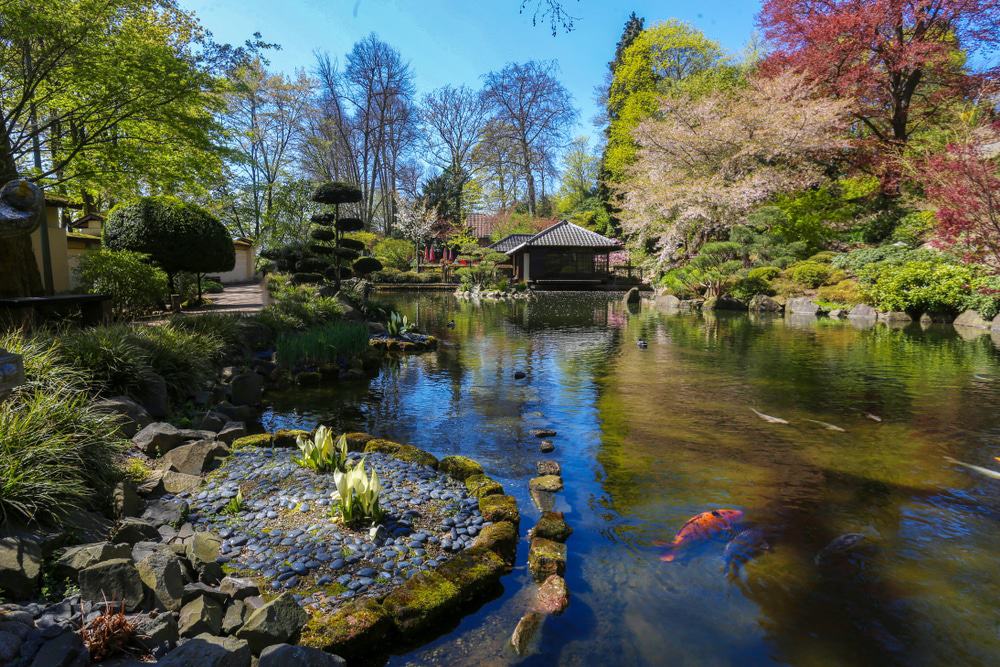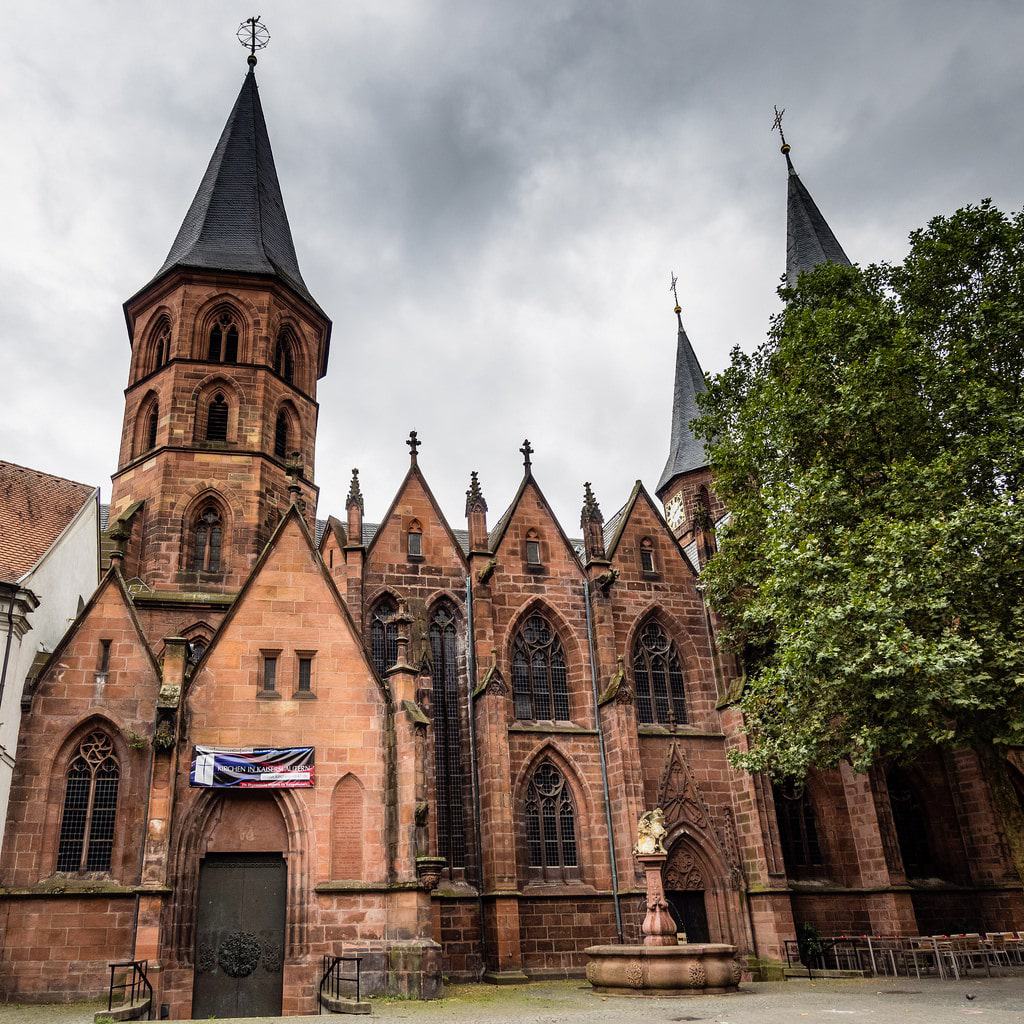In southwest Germany, Kaiserslautern is a scenic city in the wooded hills of the Palatinate Forest. This landscape had been a royal estate since the days of Charlemagne, and the “Kaiser” in the city’s name comes from the Holy Roman Emperors Frederick I (Barbarossa) and Rudolf I who resided here in the 12th and 13th centuries.
Fast forward to the year 2000 and Kaiserslautern hosted the inaugural Rhineland-Palatinate garden show, conceiving a magical themed park with dinosaurs and a genuine Japanese garden. For culture the Pfalzgalerie is replete with high-profile Impressionist, Expressionist and contemporary German works.
Let’s explore the best things to do in Kaiserslautern:
1. Gartenschau
 Source: Heribert Bechen / flickr
Source: Heribert Bechen / flickrIn 2000 Kaiserslautern put on Rhineland-Palatinate’s first state garden show (Landesgartenschau), and designed this park for the event.
Incorporating the Kaiserberg hill, the park was laid out on the grounds of a former slaughterhouse and spinning mill.
Kids who are in their dinosaur phase will love the Gartenschau as there are life-sized models of dinosaurs all across the park.
There’s also an adventure golf course, a cactus garden, a host of colourful flowerbeds, while on Kaiserberg stands a church made from willow branches.
In the buildings of the old spinning mill there has also been a Lego exhibition since 2015.
2. Museum Pfalzgalerie Kaiserslautern
 Source: E.K. /commons.wikimedia
Source: E.K. /commons.wikimediaIn the centre of Kaiserslautern near the town hall is a museum for art from the 1800s to the 2000s.
The Pfalzgalerie was set up in the 1870s and was the brainchild of the Palatine president Paul von Braun.
The permanent exhibition is a comprehensive trip through the last 200 years of German art, beginning with Neoclassicism (Anselm Feuerbach), through Romanticism (Carl Spitzweg), Impressionism (Lovis Corinth, Max Liebermann), Expressionism (Kirchner, Heckel, Pechstein), New Objectivity (Otto Dix, Kanoldt) and into post-war art by Luciana Fontana, Hans Arp, Kiki Smith to name a few.
On the second floor there are also decorative arts from the 1400s to the present, with goldsmith work, glass, furniture and textiles.
3. Japanischer Garten
 Source: shutterstock
Source: shutterstockAlso completed in 2000 for the Landesgartenschau is one of the largest Japanese gardens in Europe.
In the late 90s the city set out to create a completely authentic garden and a delegation from Kaiserslautern even visited its sister city, Bunkyō in Tokyo for advice.
The garden that eventually came about isn’t just a tranquil place to relax, but puts on Japanese festivals like Hanami and Tanabata, stages tea ceremonies and hosts Japanese literature readings.
There are moss gardens, ponds, waterfalls, rock gardens with gravel, all imbued with hidden meaning.
4. Stiftskirche
 Source: Les Williams / flickr
Source: Les Williams / flickrOn Kaiserslautern’s former marketplace is the oldest Gothic hall church between the Rhine and Saar rivers.
This beguiling sandstone monument has its roots in a monastery from the 12th century and was constructed from the mid-13th century over the foundations of that previous building.
That is when the oldest part, the elongated choir took shape, while the hall nave came a few decades later in the 1300s.
In 2009 a carillon with 47 bells was installed in one of the west towers and this chimes seven times a day between 09:31 and 20:01.
5. Burg Hohenecken
 Source: Jonathan Salley / flickr
Source: Jonathan Salley / flickrYou’ll be able to spot the ruins of this Hohenstaufen era castle from a long way away.
The fortress is elevated on a rocky spur 365 metres up on Schlossberg hill, southwest of Kaiserslautern.
In 1689 during the Nine Years’ War, Burg Hohenecken was obliterated by the French army.
But more than 300 years after that destruction there’s a lot of Medieval architecture to see.
This goes back to the beginning of the 1200s when the pentagonal main tower (Bergfried) and shield wall were raised, and both are in surprisingly good shape.
6. Humberg Tower
 Source: Benjamin Reinhard / wikipedia
Source: Benjamin Reinhard / wikipediaAt the turn of the 20th century Kaiserslautern’s entrepreneurs and industrialists pooled together to build this Wilhelmine observation tower on the Humberg hill to the southeast of the city.
The sandstone edifice has Medieval flourishes like false machicolations, and at 425 metres above sea level has far-reaching views to the north and west across the city.
There a spiral staircase of 130 steps to the observation platform at 28 metres, where a toposcope indicates the landmarks in the distance.
7. Kaiserbrunnen
 Source: E.K. / wikipedia
Source: E.K. / wikipediaAt Mainzer Tor in the east of the city centre, the Kaiserbrunnen is a bronze and sandstone sculptural work from 1987. With a whimsical style, the fountain is a crash course in Kaiserslautern’s history as well as its modern peculiarities, but is also loaded with hidden symbolism.
There are hints from the past like a Napoleon hat and the busts of Holy Roman Emperors Frederick I and Rudolf I. Look hard and you’ll find the city’s seal, as well as contemporary hallmarks like a sewing machine made by the brand Pfaff, and an engine for an Opel car.
Among the animals in the fountain are a pike, which is Kaiserslautern’s heraldic animal, and a mouse the personal signature of the fountain’s maker Gernot Rumpf.
8. Theodor-Zink-Museum
 Source: E.K. / wikipedia
Source: E.K. / wikipediaA gorgeous 19th-century house with a courtyard has been the home of Kaiserslautern’s city museum since 1978. The museum itself was founded in 1934 and over 80 years has curated a superb array of artefacts telling Kaiserslautern’s story.
Going back to the earliest days, there are mysterious shards of Neolithic pottery and pieces of Bronze Age jewellery and decoration.
You’ll see one of Carolingian capitals from the Stiftskirche predecessor, a model of the city from the Early Modern Age and paintings of Kaiserslautern’s bourgeois families.
All the products manufactured by Kaiserslautern factories during the industrial age are on show, from sewing machines to bicycles, while there’s also valuable porcelain, faience, earthenware and stoneware by Frankenthal manufactories.
9. Volkspark
 Source: Immanuel Giel / wikipedia
Source: Immanuel Giel / wikipediaThis park came about thanks to the Palatinate Craft Show of 1925. Older residents still call the Volkspark “Austellung” (Exhibition). The exhibition halls were bombed out in the war were replaced in 1959 with lawns, sports facilities, botanical flowerbeds and a duck pond.
In 2001 a bandstand was erected in the park and this stages a line-up of concerts in summer.
On Sundays the Frühschoppenkonzert is a weekly institution, while there also a medieval themed market in the Volksmarkt on alternating years in August.
10. 1. FC Kaiserslautern
 Source: Textilvergehen / flickr
Source: Textilvergehen / flickrTwenty years ago Kaiserslautern’s football team was one of the biggest in the country, having won the Bundesliga twice in 1991 and 1998. That second title took place in amazing circumstances, as the club had only been promoted from the 2. Bundesliga the season before.
But since 2012 Die Roten Teufel (The Red Devils) have been permanently in the second division of German football.
Kaiserslautern do have the home ground of a top-level club, and the 50,000-capacity Fritz-Walter-Stadion hosted five matches during the 2006 World Cup.
If you’re in the mood for some action it won’t be hard to get a ticket on match-days when the arena is only half full.
You can also take a stadium tour on most weekends to see the VIP area, changing rooms, dugouts and press conference room.
11. St.-Martins-Platz
 Source: E.K. / wikipedia
Source: E.K. / wikipediaThis cute square in the old town is cloistered by 18th and 19th-century buildings and came through the Second World War with minimal damage.
At St.-Martins-Platz the scene is set by a bar terrace under three large chestnut trees and the murmur of the Fontainebrunnen fountain.
That multi-tiered monument is the work of 20th-century sculptor and has swans and gargoyles and is crested by a golden putto.
In medieval times St.-Martins-Platz was at the entrance to the old town and was where grain would be stored.
Later it featured the long gone Hotel Zum Donnersberg where famous figures like King Ludwig I of Bavaria, Victor Hugo and Napoleon stayed or dined.
In the north of the square is Kaiserslautern’s former town hall, and is now a school but still sports the city’s coat of arms.
12. Martinskirche
 Source: Mor65_Mauro Piccardi / Shutterstock.com
Source: Mor65_Mauro Piccardi / Shutterstock.comKaiserslautern’s Catholic parish church was once joined to a Franciscan monastery and has the simple lines and understated decoration that are trademarks of that order.
The church is in a historic part of the city, positioned right against the Medieval defensive wall, with traces of that structure still visible.
Standing outside, one of the usual things about the building is its lack of a tower, and instead there’s a small Baroque steeple on the hipped roof.
The interior has been reworked many times since the church was raised in the late 13th century, but you could allow a few minutes to appreciate the stuccowork on the nave ceiling, the sandstone baptismal font (1516) and the ribbed vaulting and slender ogival windows in the choir.
The old rectory garden behind the church is a repository for historic gravestones from Kaiserslautern’s cemeteries.
13. Mikveh Jewish Ritual Bath
 Source: Stadt Kaiserslautern / kaiserslautern
Source: Stadt Kaiserslautern / kaiserslauternIn 1995 excavations on Am Altenhof unearthed an absorbing piece of Jewish heritage, a mikveh bath going back to the 1300s.
It was found by chance during construction work and dates to a specific window before the Jewish population was expelled from Kaiserslautern in 1398. The bath is carved into the bedrock and measures 2.5 by 2.5 metres.
After its discovery the mikveh was placed under a little pavilion, and if you’re interested in coming to see it you can request a tour from the tourist office.
14. Freibad Waschmühle
 Source: Mathias736 / commons.wikimedia
Source: Mathias736 / commons.wikimediaThere were no half measures when Kaiserslautern’s swimming club built this outdoor pool in a on the site of an old washing mill in 1908. In a narrow valley and with a total water surface of 7,400 square metres, the pool is 165.3 metres long and has changing rooms in the Art Nouveau style.
Freibad Waschmühle’s water is sourced from wells and fluctuates between a refreshing 19 °C at the start and end of the season to 26°C in July and August.
The wooded scenery in the valley as well as the pool’s lawns and playgrounds make this a favourite place for families to pass a balmy summer afternoon.
15. Wildpark Betzenberg
 Source: Heribert Bechen / flickr
Source: Heribert Bechen / flickrOn a hill east of the city is a wild animal park that was established in 1970. Wildpark Betzenberg has several species that used to roam the woods and countryside around the city but are mostly no longer native to the region.
In a 25-hectare reserve shaded by 125-year-old oaks, beeches and conifers there are aurochs, mouflons, lynxes, wild boars, owls and red deer.
The Wildpark also takes part in a conservation programme for the bison, which is endangered in Europe.
